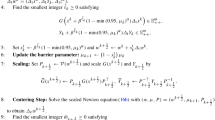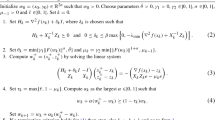Abstract
In this paper, we study the global convergence of a large class of primal—dual interior point algorithms for solving the linearly constrained convex programming problem. The algorithms in this class decrease the value of a primal—dual potential function and hence belong to the class of so-called potential reduction algorithms. An inexact line search based on Armijo stepsize rule is used to compute the stepsize. The directions used by the algorithms are the same as the ones used in primal—dual path following and potential reduction algorithms and a very mild condition on the choice of the “centering parameter” is assumed. The algorithms always keep primal and dual feasibility and, in contrast to the polynomial potential reduction algorithms, they do not need to drive the value of the potential function towards — ∞ in order to converge. One of the techniques used in the convergence analysis of these algorithms has its root in nonlinear unconstrained optimization theory.
Similar content being viewed by others
References
D.P. Bertsekas,Constrained Optimization and Lagrange Multiplier Methods (Academic Press, London, 1982).
R.S. Dembo, “Dual to primal conversion in geometric programming,”Mathematical Programming 26 (1978) 243–252.
I.I. Dikin, “Iterative solution of problems of linear and quadratic programming,”Soviet Mathematics Doklady 8 (1967) 674–675.
D.-Z. Du and X.-S Zhang, “Global convergence of Rosen's gradient projection method,”Mathematical Programming 44 (1989) 357–366.
R. Fletcher,Practical Methods of Optimization (Wiley, New York, 1987).
C.C. Gonzaga, “An algorithm for solving linear programming problems in O (n 3 L) operations,” in: N. Megiddo, ed.,Progress in Mathematical Programming: Interior Point Algorithms and Related Methods (Springer, New York, 1989) pp. 1–28.
O. Guler, “Existence of interior points and interior paths in nonlinear monotone complementarity problems,”Mathematics of Operations Research 18 (1993) 128–147.
D. den Hertog, C. Roos and T. Terlaky, “On the classical logarithmic barrier function method for a class of smooth convex programming problems,”Journal of Optimization Theory and Applications 73 (1992) 1–25.
D. den Hertog, C. Roos and T. Terlaky, “A large-step analytic center method for a class of smooth convex programming problems”,SIAM Journal on Optimization 2 (1992) 55–70.
F. Jarre, G. Sonnevend and J. Stoer, “On the complexity of a numerical algorithm for solving generalized convex quadratic programs by following a central path, in: J.C. Lagarias and M.J. Todd, editors,Mathematical Developments Arising from Linear Programming: Proceedings of a Joint Summer Research Conference held at Bowdoin College, Brunswick, Maine, USA, June/July 1988, volume 114 ofContemporary Mathematics (American Mathematical Society, Providence, Rhode Island, USA, 1990) pp. 233–242.
N. Karmarkar, “A new polynomial time algorithm for linear programming,”Combinatorica 4 (1984) 373–395.
M. Kojima, N. Megiddo and S. Mizuno, “Theoretical convergence of large-step primal—dual interior point algorithms for linear programming,”Mathematical Programming 59 (1993) 1–21.
M. Kojima, N. Megiddo and T. Noma, “Homotopy continuation methods for nonlinear complementarity problems,”Mathematics of Operations Research 16 (1991) 754–774.
M. Kojima, N. Megiddo, T. Noma and A. Yoshise, “A unified approach to interior point algorithms for linear complementarity problems,” in:Lecture Notes in Computer Science No. 538 (Springer, Berlin, 1991).
M. Kojima, S. Mizuno and T. Noma, “Limiting behavior of trajectories generated by a continuation method for monotone complementarity problems,”Mathematics of Operations Research 15 (1990) 662–675.
M. Kojima, S. Mizuno and A. Yoshise, “A polynomial-time algorithm for a class of linear complementarity problems,”Mathematical Programming 44 (1989) 1–26.
M. Kojima, S. Mizuno and A. Yoshise, “A primal-dual interior point algorithm for linear programming,” in: N. Megiddo, ed.,Progress in Mathematical Programming: Interior Point Algorithms and Related Methods (Springer, New York, 1989) pp. 131–158.
M. Kojima, S. Mizuno and A. Yoshise, “An O(√nL) iteration potential reduction algorithm for linear complementarity problems,” Mathematical Programming 50 (1991) 331–342.
K.O. Kortanek, F. Potra and Y. Ye, “On some efficient interior point methods for nonlinear convex programming,”Linear Algebra and its Applications 152 (1991) 169–189.
K.O. Kortanek and J. Zhu, “A polynomial barrier algorithm for linearly constrained convex programming problems,”Mathematics of Operations Research 18 (1993) 116–127.
L. McLinden, “The complementarity problem for maximal monotone multifunctions,” in: R.W. Cottle, F. Giannessi and J.-L. Lions, eds.,Variational Inequalities and Complementarity Problems (Wiley, New York, 1980) pp. 251–270.
N. Megiddo, “Pathways to the optimal set in linear programming,” in: N. Megiddo, ed.,Progress in Mathematical Programming: Interior Point Algorithms and Related Methods (Springer, New York, 1989) pp. 131–158.
S. Mehrotra and J. Sun, “An interior point algorithm for solving smooth convex programs based on Newton's method,” in: J.C. Lagarias and M.J. Todd, ed.,Contemporary Mathematics: Proceedings of the AMS—IMS—SIAM Joint Summer Research Conference on “Mathematical Developments Arising from Linear Programming”, held at Bowdoin College, Brunswick, Maine on July 25–31, 1988, vol. 114 (AMS, Province, RI, 1990) pp. 265–284.
S. Mizuno, M.J. Todd and Y. Ye, “On adaptive step primal-dual interior-point algorithms for linear programming,”Mathematics of Operations Research 18 (1993) 945–981.
S. Mizuno, A. Yoshise and T. Kikuchi, “Practical polynomial time algorithms for linear complementarity problems,”Journal of the Operations Research Society of Japan 32 (1989) 75–92.
R.D.C. Monteiro and I. Adler, “Interior path following primal—dual algorithms. Part II: Convex quadratic programming,”Mathematical Programming 44 (1989) 43–66.
R.D.C. Monteiro and I. Adler, “Interior path following primal—dual algorithms. Part I: Linear programming,”Mathematical Programming 44 (1989) 27–41.
R.D.C. Monteiro and I. Adler, “An extension of kamarkar type algorithm to a class of convex separable programming problems with global linear rate of convergence,”Mathematics of Operations Research 15 (1990) 408–422.
R.D.C. Monteiro, I. Adler and Mauricio G.C. Resende, “A polynomial-time primal—dual affine scaling algorithm for linear and convex quadratic programming and its power series extension,”Mathematics of Operations Research 15 (1990) 191–214.
J.J. Moré, “Class of functions and feasibility conditions in nonlinear complementarity problem,”Mathematical Programming 6 (1974) 327–338.
Y.E. Nesterov and A.S. Nemirovsky, “A general approach to the design of optimal methods for smooth convex functions minimization,”Ekonomika i Matem. Metody 24 (1988) 509–517. (In Russian; English transl. Matekon: Translations of Russian and East European Math. Economics.)
J.S. Pang, “Iterative descent methods for a row sufficient linear complementarity problem,”SIAM Journal on Matrix Analysis and Applications 12 (1991) 611–624.
J. Renegar, “A polynomial-time algorithm based on Newton's method for linear programming,”Mathematical Programming 40 (1988) 59–93.
R.T. Rockafellar,Convex Analysis (Princeton University Press, Princeton, NJ, 1970).
G. Sonnevend, “An analytical centre for polyhedrons and new classes of global algorithms for linear (smooth, convex) programming,” in: A. Prekopa, ed.,Lecture Notes in Control and Information Sciences, No. 84 (Springer, Berlin, 1985) pp. 866–876.
K. Tanabe, “Complementarity-enforcing centered Newton method for mathematical programing: global theory,” in: K. Tone, ed.,New Methods for Linear Programming (The Institute of Statistical Mathematics, Tokyo, 1987) pp. 118–144.
K. Tanabe, “Centered Newton method for mathematical programming,” in: M. Iri and K. Yajima, eds.,Systems Modelling and Optimization (Springer, New York, 1988) pp. 197–206.
M.J. Todd and Y. Ye, “A centered projective algorithm for linear programming,”Mathematics of Operations Research 15 (1990) 508–529.
P. Tseng, “Global linear convergence of a path following algorithm for some monotone variational inequality problems.”Journal of Optimization Theory and Applications. 75 (1992) 265–279.
P.M. Vaidya, “An algorithm for linear programming which requires O((m + n)n 2 +(m + n)L) arithmetic operations,”Mathematical Programming 47 (1990) 175–202.
Y. Ye, “An O(n 3 L) potential reduction algorithm for linear programmig,”Mathematical Programming 50 (1991) 239–258.
F.A. Potra and Y. Ye, A quadratically convergent polynomial algorithm for solving entropy optimization problems,SIAM Journal on Optimization 3 (1993) 843–861.
J. Zhu, “A path following algorithm for a class of convex programming problems,”ZOR — Methods and Models of Operations Research 36 (1992) 359–377.
Author information
Authors and Affiliations
Additional information
Research supported in part by NSF Grant DDM-9109404.
Rights and permissions
About this article
Cite this article
Monteiro, R.D.C. A globally convergent primal—dual interior point algorithm for convex programming. Mathematical Programming 64, 123–147 (1994). https://doi.org/10.1007/BF01582568
Received:
Revised:
Issue Date:
DOI: https://doi.org/10.1007/BF01582568




